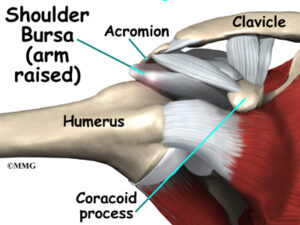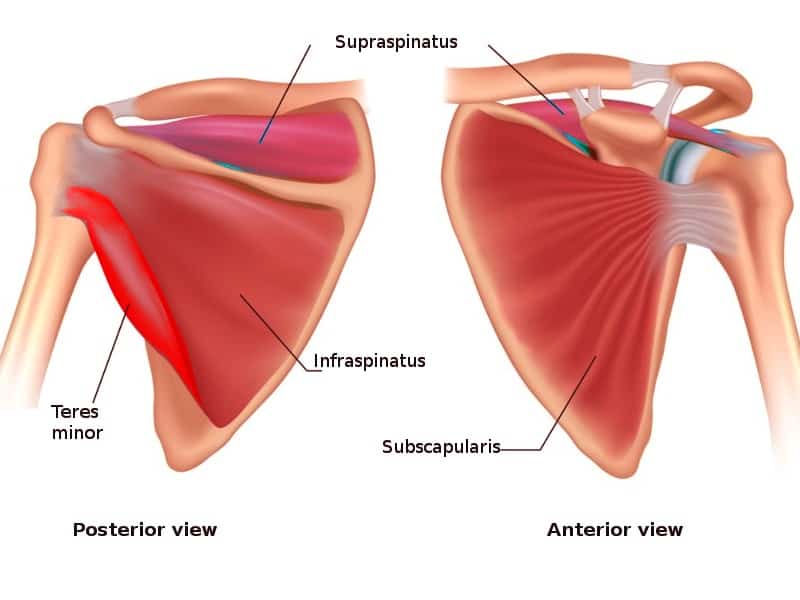If you are like most people, you probably have never heard of the rotator cuff until you suffered an injury to it. A rotator cuff is a group of muscles and tendons that stabilize the shoulder joint. When these muscles or tendons become injured, it can be very painful and difficult to move your arm. In this blog post, we will discuss the causes, symptoms, and treatment options for rotator cuff injuries.
Contents
What Is A Rotator Cuff?

The rotator cuff is a group of muscles and tendons in the shoulder that work together to stabilize the joint. These muscles and tendons can be injured by repetitive overhead motions or sudden trauma, resulting in pain and decreased range of motion.
Rotator cuff injuries are common, particularly in athletes who participate in overhead sports such as baseball, tennis, and volleyball. The risk of developing a rotator cuff injury increases with age, as the muscles and tendons become weaker and more prone to injury.
Symptoms Of A Rotator Cuff Injury
The most common symptom of a rotator cuff injury is pain. You may have:
- Pain when reaching overhead or behind your back
- Pain when lying on your shoulder
- Weakness in your arm
- A crackling sensation when moving your shoulder
If you have a rotator cuff tear, you may also feel a dull ache in your shoulder.
Causes Of Rotator Cuff Injuries

A rotator cuff is a group of four muscles and tendons that hold your shoulder joint in place. These muscles and tendons can become weak or damaged with age or overuse. A rotator cuff injury is often caused by:
Age-related wear and tear: The risk of developing a rotator cuff injury increases with age. This is due to the natural process of wear and tear on the tendons.
Trauma: A direct blow to the shoulder or a fall onto the shoulder can cause a rotator cuff injury.
Overuse of your arm, such as from throwing a baseball: This is the most common cause of a rotator cuff tear. For instance, the rotator cuff muscles and tendons help lift your arm.
A fall on an outstretched arm: A rotator cuff tear may occur gradually from overuse or it can happen suddenly, such as from a fall. This can cause a rotator cuff tear or dislocation of your shoulder joint.
A direct blow to your shoulder: If you get hit directly on your shoulder, it can cause a rotator cuff tear or dislocation. A car accident is one example of how this might happen.
Lifting something too heavy: Lifting a heavy object incorrectly can put too much strain on your rotator cuff and cause a tear.
A sudden movement: If you make a quick, jerking motion with your arm, it can cause a rotator cuff tear. Throwing a ball is one example of this. Climbing: If you fall while you’re rock climbing, the resulting force can cause a rotator cuff tear.
Repetitive stress: Repeating the same arm motions over and over again can put too much stress on your rotator cuff muscles and tendons. This is a common cause of rotator cuff injuries in athletes and people who do manual labor.
Degeneration: As you age, the tendons in your rotator cuff can weaken and degenerate (wear down). This makes them more susceptible to tears. Diseases such as arthritis can also lead to rotator cuff injuries.
What are the symptoms of a rotator cuff injury?
There are various symptoms. They are as follows:
Pain in the shoulder: This is the most common symptom. The pain may be mild to severe. It may be a dull ache or a sharp pain. For example, you may have pain when you try to reach overhead or when you lie on your side.
Weakness in the shoulder: You may have difficulty doing everyday activities, such as combing your hair or reaching for a dish on a high shelf. For example, you may have a weakness when you lift your arm out to the side or overhead. This is called an external rotation deficit. You may feel that your arm is weaker than normal, and you may have trouble doing everyday tasks such as combing your hair or reaching into a cupboard
Pain with movement: You may feel pain when you move your shoulder, especially if you try to raise your arm above your head. The pain may also radiate down your arm. For instance, you may feel pain when reaching up to get something from a high shelf.
Limited range of motion: You may find that you can’t move your shoulder as much as usual.
If you have a rotator cuff injury, you may find that your shoulder has a limited range of motion. This means that you won’t be able to move it as much as you normally would.
Tenderness: When pressing on the rotator cuff muscles or tendons. For example, they may feel pain when reaching up or when lying on the affected shoulder.
Stiffness: Many times, the shoulder will feel stiff after a rotator cuff injury. This is due to the inflammation and swelling around the tendons. The shoulder may feel like it ” catches” when you move it.
Cracking or popping sounds: When moving the arm or shoulder, you may hear a cracking or popping sound emanating from the rotator cuff area. This is often caused by tendonitis, bursitis, or impingement syndrome and can be very painful.
Difficulty moving the arm or shoulder: Pain and weakness in the shoulder and arm can make it difficult to move the arm away from the body or overhead. The shoulder may feel sore even when you’re not using it. Disrupted sleep is a common symptom of a rotator cuff injury.
How Are Rotator Cuff Injuries Diagnosed?
The diagnosis of a rotator cuff injury is usually done on the basis of :
Patient’s history: The doctor will ask how the injury occurred, and if the pain is constant or intermittent. He will also enquire about any previous shoulder injuries or conditions.
Clinical examination: The doctor will check for signs of tenderness, muscle weakness, and reduced range of motion. He may also conduct special tests, such as the Empty Can Test, to check for a rotator cuff tear.
X-rays: X-rays are usually done to rule out other conditions that can cause shoulder pain, such as arthritis or a fracture.
MRI scan: An MRI scan is the best test to diagnose a rotator cuff tear. It can show the size and location of the tear, as well as any inflammation or degeneration of the tendons.
Ultrasound scan: Ultrasound scans are less commonly used to diagnose rotator cuff injuries, but can be helpful in some cases.
How Are Rotator Cuff Injuries Treated?
The treatment of a rotator cuff injury will depend on the severity of the injury. They are included as follows:
Rest
The first step in treating a rotator cuff injury is to rest the shoulder and allow the inflammation to settle. Avoiding activities that require overhead motions of the arm or putting stress on the shoulder can help rest and heal the rotator cuff. This may mean avoiding certain sports or modifying your activity. For example, if you play tennis, try playing with lower-power strokes.
Ice
Applying ice to the shoulder for 15-20 minutes several times a day can help to reduce swelling and pain. For instance, you might try ice after an activity that aggravates your shoulder. You can also use ice packs or bags of frozen peas wrapped in a towel.
Anti-inflammatory medication
Over-the-counter anti-inflammatory medications, such as ibuprofen (Advil, Motrin IB) and naproxen (Aleve), can help to reduce pain and inflammation. Be sure to follow the directions on the package.
Corticosteroid injections
A corticosteroid injection into the shoulder can help to reduce inflammation. This can provide relief for several months. If conservative measures are not effective, your doctor may recommend a corticosteroid injection into the shoulder to help reduce pain and inflammation.
Non-steroidal anti-inflammatory drugs (NSAIDs)
Taking over-the-counter NSAIDs, such as ibuprofen (Advil) or naproxen (Aleve), can help to reduce pain and inflammation. Use these medications as directed on the label.
NSAIDs can interact with other medications, and they can cause stomach bleeding and ulcers. If you have heart disease, high blood pressure, kidney problems, or are on a salt-restricted diet, talk to your doctor before taking NSAIDs.
Surgery
In some cases, surgery may be necessary to repair the rotator cuff. This is typically only done if other treatments have not been effective in relieving pain and restoring function. For example, if the rotator cuff is completely torn, surgery may be needed to reattach the tendon to the bone.
Recovery
Recovery time after rotator cuff surgery varies depending on the extent of the injury and the type of surgery performed. However, most people can expect to take several weeks before they are able to fully return to their normal activities.
Physical therapy
After surgery, it is important to begin a physical therapy program to help restore strength and range of motion in the shoulder. A physical therapist can also teach you exercises to help prevent future injuries.
Stretching and strengthening exercises
A rotator cuff is a group of muscles and tendons that attach the shoulder blade to the upper arm bone. These muscles and tendons help lift the arm. The rotator cuff can be injured by repetitive overhead motions of the arm or by a sudden fall on an outstretched hand.
If you have a rotator cuff injury, it is important to start treatment as soon as possible. Early treatment can help prevent the injury from getting worse and reduce your risk of developing chronic shoulder pain.
Conclusion
It may be concluded that rotator cuff injury is a significant cause of shoulder pain and dysfunction. While the exact prevalence is unknown, it is estimated that rotator cuff tears are responsible for approximately 16% of all shoulder problems. It may be stated that the rotator cuff is essential for normal shoulder function, and injury to this area can lead to significant pain and disability. Treatment of rotator cuff tears often requires surgery, and rehabilitation following surgery is essential for proper recovery.
Physical Therapy help patients recover from pain. If you’re experiencing Back pain, Shoulder pain, Knee pain, Neck pain, Elbow pain, Hip pain, or Arthritis pain, a physical therapist at MantraCare can help: Book a physiotherapy session.


